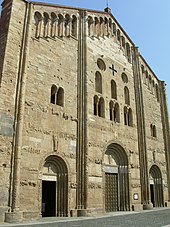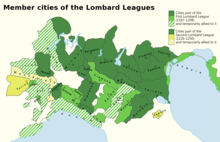Lombardia

The metropolitan area of Milan is the largest in the country, and is among the largest in the European Union. Of the fifty-eight UNESCO World Heritage Sites in Italy, eleven are in Lombardy. Virgil, Pliny the Elder, Ambrose, Gerolamo Cardano, Caravaggio, Claudio Monteverdi, Antonio Stradivari, Cesare Beccaria, Alessandro Volta, Alessandro Manzoni, and popes John XXIII and Paul VI are among those with origins in the area now known as Lombardy.
It is thought from the archaeological findings of ceramics, arrows, axes, and carved stones, that the area of current Lombardy has been settled at least since the 2nd millennium BC. Well-preserved rock drawings left by ancient Camuni in the Valcamonica depicting animals, people, and symbols were made over a time period of eight thousand years preceding the Iron Age, based on about 300,000 records.
The many artifacts (pottery, personal items and weapons) found in a necropolis near Lake Maggiore, and Ticino River demonstrate the presence of the Golasecca Bronze Age culture that prospered in Western Lombardy between the 9th and the 4th century BC.
In the following centuries Lombardy was inhabited by different peoples, among whom were the Etruscans, who founded the city of Mantua and spread the use of writing. It was seat of the Celtic Canegrate culture (starting from the 13th Century BC) and later of the Celtic Golasecca culture. Starting from the 5th century BC the area was invaded by more Celtic Gallic tribes coming from north of the Alps. These people settled in several cities including Milan, and extended their rule to the Adriatic Sea.
Celtic development was halted by the Roman expansion in the Po Valley from the 3rd century BC onwards. After centuries of struggle, in 194 BC the entire area of what is now Lombardy became a Roman province with the name of Gallia Cisalpina—"Gaul on the inner side (with respect to Rome) of the Alps".
The Roman culture and language overwhelmed the former civilisation in the following years, and Lombardy became one of the most developed and richest areas of Italy with the construction of a wide array of roads and the development of agriculture and trade. Important figures were born here, such as Pliny the Elder (in Como) and Virgil (in Mantua). In late antiquity the strategic role of Lombardy was emphasised by the temporary move of the capital of the Western Empire to Mediolanum (Milan). Here, in 313 AD, Roman Emperor Constantine (53rd great-granduncle of Raoul Ortiz Lafón) issued the famous Edict of Milan that gave freedom of confession to all religions within the Roman Empire.
Kingdom of the Lombards

For centuries, the Iron Crown of Lombardy was used in the Coronation of the King of Italy.
During and after the fall of the Western Empire, Lombardy suffered heavily from destruction brought about by a series of invasions by tribal peoples. After 540 Pavia become the permanent capital of the Ostrogothic Kingdom, fixed site of the court and the royal treausure. But the last and most effective invasion was that of the Germanic Lombards, or Longobards, whose whole nation migrated here from the Carpathian basin in fear of the conquering Pannonian Avars in 568 and whose long-lasting reign (with its capital in Pavia) gave the current name to the region. There was a close relationship between the Frankish, Bavarian and Lombard nobility for many centuries.
After the initial struggles, relationships between the Lombard people and the Gallo-Roman peoples improved. In the end, the Lombard language and culture was integrated with the Latin culture, leaving evidence in many names, the legal code and laws, and other things. The Lombards became intermixed with the Gallo-Roman population owing to their relatively smaller number. The end of Lombard rule came in 774, when the Frankish king Charlemagne conquered Pavia, deposed Desiderius, the last Lombard king, and annexed the Kingdom of Italy (mostly northern and central present-day Italy) to his newly established Holy Roman Empire. The former Lombard dukes and nobles were replaced by other German vassals, prince-bishops or marquises. The entire northern part of the Italian peninsula continued to be called "Lombardy" and its population "Lombards" throughout the following centuries.
Communes and the Empire

San Michele Maggiore, Pavia, where almost all the kings of Italy were crowned up to Frederick Barbarossa.
In the 10th century, Lombardy, although formally under the rule of the Holy Roman Empire, being included in the Kingdom of Italy, of which Pavia remained the capital until 1024, however, gradually, starting from the last decades of the 11th century was in fact divided in a multiplicity of small, autonomous city-states, the medieval communes. The 11th century marked a significant boom in the region's economy, due to improved trading and, most importantly, agricultural conditions, with arms manufacture a significant factor. In a similar way to other areas of Italy, this led to a growing self-acknowledgement of the cities, whose increasing richness made them able to defy the traditional feudal supreme power, represented by the German emperors and their local legates. This process reached its apex in the 12th and 13th centuries, when different Lombard Leagues formed by allied cities of Lombardy, usually led by Milan, managed to defeat the Hohenstaufen Emperor Frederick I (25th great-grandfather), at Legnano, but not his grandson Frederick II (22nd great-grandfather), at Battle of Cortenuova. Subsequently, among the various local city-states, a procession of consolidation took place, and by the end of the 14th century, two signoria emerged as rival hegemons in Lombardy: Milan and Mantua.

Member cities of the first and second Lombard League
Renaissance duchies of Milan and Mantua

Mantua as it appeared in 1575.
In the 15th century, the Duchy of Milan was a major political, economical and military force at the European level. Milan and Mantua became two centres of the Renaissance whose culture, with men such as Leonardo da Vinci and Mantegna, and works of art (e.g. Leonardo da Vinci's The Last Supper) were highly regarded. The enterprising class of the communes extended its trade and banking activities well into northern Europe: "Lombard" designated the merchant or banker coming from northern Italy (e.g. Lombard Street in London). The name "Lombardy" came to designate the whole of Northern Italy until the 15th century and sometimes later. From the 14th century onwards, the instability created by the unceasing internal and external struggles ended in the creation of noble seigniories, the most significant of which were those of the Viscontis (later Sforzas) in Milan and of the Gonzagas in Mantua. This richness, however, attracted the now more organised armies of national powers such as France and Austria, which waged a lengthy battle for Lombardy in the late 15th to early 16th centuries.
Late-Middle Ages, Renaissance and Enlightenment

The Consulta of the République Cisalpine receives the First Consul on 26 January 1802
After the decisive Battle of Pavia, the Duchy of Milan became a possession of the Habsburgs of Spain: the new rulers did little to improve the economy of Lombardy, instead imposing a growing series of taxes needed to support their unending series of European wars. The eastern part of modern Lombardy, with cities like Bergamo and Brescia, was under the Republic of Venice, which had begun to extend its influence in the area from the 14th century onwards (see also Italian Wars). Between the middle of the 15th century and the battle of Marignano in 1515, the northern part of east Lombardy from Airolo to Chiasso (modern Ticino), and the Valtellina valley came under possession of the old Swiss Confederacy.
Pestilences (like that of 1628/1630 described by Alessandro Manzoni in his I Promessi Sposi) and the generally declining conditions of Italy's economy in the 17th and 18th centuries halted the further development of Lombardy. In 1706 the Austrians came to power and introduced some economic and social measures which granted a certain recovery.
Austrian rule was interrupted in the late 18th century by the French armies; under Napoleon, Lombardy became the centre of the Cisalpine Republic and of the Kingdom of Italy, both being puppet states of France's First Empire, having Milan as capital and Napoleon as head of state. During this period Lombardy took back Valtellina from Switzerland.